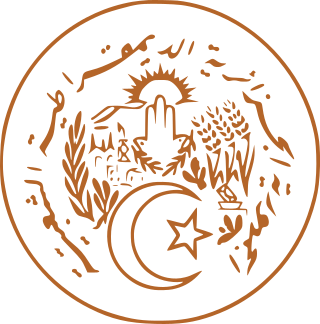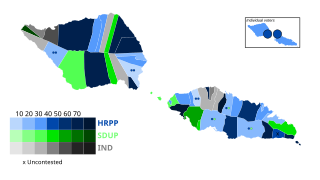
Politics of American Samoa takes place in a framework of a presidential representative democratic dependency, whereby the governor is the head of government, and of a pluriform multi-party system. American Samoa is an unincorporated and unorganized territory of the United States, administered by the Office of Insular Affairs, U.S. Department of the Interior. Its constitution was ratified in 1966 and came into effect in 1967. Executive power is discharged by the governor and the lieutenant governor. Legislative power is vested in the two chambers of the legislature. The party system is based on the United States party system. The judiciary is independent of the executive and the legislature.

Politics of Samoa takes place in a framework of a parliamentary representative democratic state whereby the Prime Minister of Samoa is the head of government. Existing alongside the country's Western-styled political system is the fa'amatai chiefly system of socio-political governance and organisation, central to understanding Samoa's political system.

A member of parliament (MP) is the representative in parliament of the people who live in their electoral district. In many countries with bicameral parliaments, this term refers only to members of the lower house since upper house members often have a different title. The terms congressman/congresswoman or deputy are equivalent terms used in other jurisdictions. The term parliamentarian is also sometimes used for members of parliament, but this may also be used to refer to unelected government officials with specific roles in a parliament and other expert advisers on parliamentary procedure such as the Senate parliamentarian in the United States. The term is also used to the characteristic of performing the duties of a member of a legislature, for example: "The two party leaders often disagreed on issues, but both were excellent parliamentarians and cooperated to get many good things done."

Algeria elects on the national level a head of state – the president – and a legislature. The president is elected for a five-year term by the people. People's National Assembly has 407 members, elected for a five-year term in multi-seat constituencies by proportional representation. Eight seats in the national assembly are reserved for Algerians abroad. The Council of the Nation has 144 members, 96 members elected by communal councils and 48 members appointed by the president.

Elections in Mexico are held every 6 years to elect a president and every 3 years to elect a legislature. These elections determine who, on the national level, takes the position of the head of state – the president – as well as the legislature.

The American Samoan Legislature or Fono has two chambers, the House of Representatives and the Senate, which has a directly elected head of government, the Governor of American Samoa.

Madagascar elects on the national level a head of state – the president – and a legislature. The president is elected for a five-year term by the people, by absolute majority through a two-round system. The Parliament has two chambers. The National Assembly has 151 members, elected for a five-year term in single-member and two-member constituencies. In single-member constituencies, representatives are elected by simple majority, in the two-member constituencies, closed party lists are used, with the two seats distributed using a highest averages method. The Senate (Sénat) has 33 members, 22 members elected by the regions by provincial electors, and 11 members appointed by the president, all for 5 year terms.

The Mäjilis of the Parliament of the Republic of Kazakhstan, commonly referred to as Mäjilis or Mazhilis is the lower house of the Parliament of Kazakhstan, alongside the upper house Senate. Together, they form the national bicameral legislature of Kazakhstan, responsible for enacting legislation. Established by the Constitution of Kazakhstan following the 1995 constitutional referendum, the Mäjilis was first convened in 1996. The chamber plays role in the legislative process, debating and passing laws, where lawmakers discuss key issues facing the country and propose solutions to address them by representing the interests of constituents.

The Territorial Assembly of Wallis and Futuna is the legislature of Wallis and Futuna. It consists of 20 members, elected for a five-year term by proportional representation in multi-seat constituencies. The Assembly sits in Mata Utu, the capital of the territory.

The Legislative Assembly, also known as the Parliament of Samoa, is the national legislature of Samoa, seated at Apia, where the country's central administration is situated. Samoan Parliament is composed of two parts: the O le Ao o le Malo and the Legislative Assembly.

The American Samoa Fono is the territorial legislature of American Samoa. Like most states and territorial legislatures of the United States, it is a bicameral legislature with a House of Representatives and a Senate. The legislature is located in Fagatogo along Pago Pago harbor.

The O le Ao o le Malo is the ceremonial head of state of Samoa. The position is described in Part III of the 1960 Samoan constitution. At the time the constitution was adopted, it was anticipated that future heads of state would be chosen from among the four Tama a 'Aiga "matai" paramount chiefs in line with customary protocol. This is not a constitutional requirement, so Samoa can be considered a parliamentary republic rather than a constitutional monarchy. The government Press Secretariat describes Head of State as a "ceremonial president". The holder is given the formal style of Highness, as are the heads of the four paramount chiefly dynasties.

General elections were held in Samoa on 31 March 2006 to determine the composition of the 14th Parliament. The main contesting parties were that of incumbent Prime Minister Tuilaʻepa Saʻilele Malielegaoi, of the Human Rights Protection Party (HRPP); and the Samoan Democratic United Party (SDUP). In addition, three other parties, the Christian Party (SCP), the Samoa Party (SP), and the Samoa Progressive Party (SPP), competed in the election. The result was a landslide victory for the HRPP, which won 33 of the 49 seats. The newly founded SDUP secured ten seats, and the remaining six were won by independents. After the election, three independents joined the HRPP, increasing the party's seat count to 36.

General elections were held in Samoa on 2 March 2001 to determine the composition of the 13th Parliament. Four parties contested the election, including the ruling Human Rights Protection Party (HRPP) and the main opposition Samoan National Development Party (SNDP). The HRPP was led into the election by Prime Minister Tuilaʻepa Saʻilele Malielegaoi, who succeeded Tofilau Eti Alesana in 1998 following his resignation.
Electoral districts go by different names depending on the country and the office being elected.

General elections were held in Western Samoa on 26 April 1996 to determine the composition of the 12th Parliament. The election occurred following constitutional amendments that extended the parliamentary term from three to five years and increased parliament's seat count from 47 to 49. Five parties contested the election, including the governing Human Rights Protection Party (HRPP), led by Prime Minister Tofilau Eti Alesana and the main opposition, the Samoan National Development Party (SNDP), led by Tui Ātua Tupua Tamasese Efi. The HRPP's popularity suffered a setback due to Chief Auditor Sua Rimoni Ah Chong's 1994 report, which brought to light government corruption. While the SNDP campaigned on anti-corruption, the party's perceived failure to provide checks on the HRPP meant the governing party faced few obstacles to re-election.

General elections were held in Western Samoa on 28 April 1948, the first to the new Legislative Assembly. The United Citizens Party won four of the five directly-elected seats.

General elections were held in Samoa on 4 March 2016 to determine the composition of the 16th Parliament. Two parties contested the election, the ruling Human Rights Protection Party (HRPP), led by Prime Minister Tuilaʻepa Saʻilele Malielegaoi, which had been in government for most of the time since 1982 and the Tautua Samoa Party (TSP), led by Opposition Leader Palusalue Faʻapo II.

The Fono of Faipule was a legislature in Western Samoa during the colonial era. It consisted of representatives (faipule) from each district.

General elections were held in Western Samoa on 15 November 1957.












